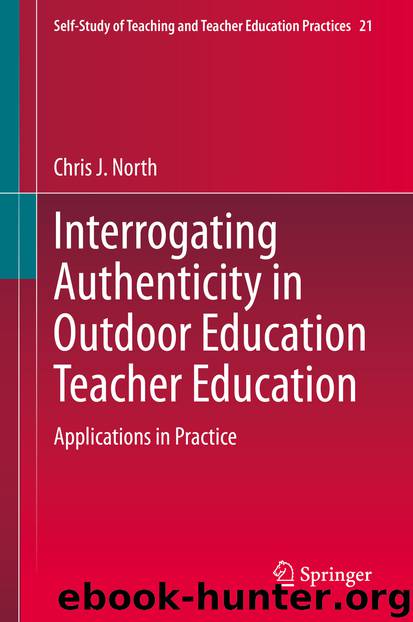Interrogating Authenticity in Outdoor Education Teacher Education by Chris J. North

Author:Chris J. North
Language: eng
Format: epub
ISBN: 9789811521768
Publisher: Springer Singapore
Summary
In the introduction to this chapter I presented various calls from the literature for teacher educators to model the approaches we promote. Modelling is important in order to provide PSTs with quality learning about becoming a teacher. As I established in chapter “Passivity and Authenticity in Teacher Education”, quality learning requires more authentic experiences. I then modelled the TBL model as a way of aligning my teaching with the expectations of graduating teachers. There were some important benefits, such as PSTs identifying their personal theories and analysing them. Also the repetitions of the TBL model during the classes created a shared language with which to reflect.
However, my modelling of the standards was generally not particularly potent for my PSTs. The reasons for this lack of influence were various and included PSTs perceiving my modelling of the TBL standards as simply a lesson structure, PSTs presenting with weaknesses which reflected my own weaknesses, and finally my colonisation and modification of the TBL model.
In their conclusion, Lunenberg et al. (2007) ponder “how teacher educators can be encouraged to use modelling more frequently and more systematically” (p. 598). Using Lunenberg et al.’s (2007) work as the basis for this chapter, I have attempted to address this question and provided evidence of systematic and frequent explicit modelling. While of some benefit to the PSTs, I found the TBL model invaluable in learning about my teaching. This chapter has shed further light on one particular approach to modelling by teacher educators.
The Aeroplane Metaphor Revisited
Using transparent teaching techniques such as explaining the upcoming turbulence on the intercom was not enough to prepare passengers to fly the plane. The pilot invited the passengers into the cockpit to see the preflight checks as well as the decisions that were being made in “real time”. The pilot’s modelling of flying the plane and sharing the protocols was only partly effective but the pilot gained valuable insights about his/her assumptions and practices when flying the educational plane.
Download
This site does not store any files on its server. We only index and link to content provided by other sites. Please contact the content providers to delete copyright contents if any and email us, we'll remove relevant links or contents immediately.
The Art of Coaching Workbook by Elena Aguilar(50735)
Trainspotting by Irvine Welsh(21407)
Twilight of the Idols With the Antichrist and Ecce Homo by Friedrich Nietzsche(18442)
Fangirl by Rainbow Rowell(9006)
Periodization Training for Sports by Tudor Bompa(8090)
Change Your Questions, Change Your Life by Marilee Adams(7551)
This Is How You Lose Her by Junot Diaz(6694)
Asking the Right Questions: A Guide to Critical Thinking by M. Neil Browne & Stuart M. Keeley(5569)
Grit by Angela Duckworth(5442)
Red Sparrow by Jason Matthews(5317)
Paper Towns by Green John(5018)
Room 212 by Kate Stewart(4956)
Ken Follett - World without end by Ken Follett(4587)
Housekeeping by Marilynne Robinson(4243)
The Sports Rules Book by Human Kinetics(4205)
Papillon (English) by Henri Charrière(4138)
Double Down (Diary of a Wimpy Kid Book 11) by Jeff Kinney(4126)
The Motorcycle Diaries by Ernesto Che Guevara(3925)
Exercise Technique Manual for Resistance Training by National Strength & Conditioning Association(3900)
